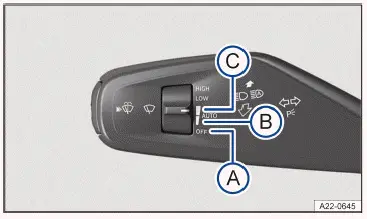Volkswagen ID.7: Operating the windshield wiper lever

Fig. 1 On the left-hand side of the steering column: lever for turn signal,
high beam and windshield wiper.
The windshield wipers only work when the ignition is switched on and the driver door, front passenger door and hood are closed.
- Operate the windshield wiper.
- Operate the one-tap wiping and automatic wiper/washer system of the windshield wipers.
Switching on the Windshield Wipers
- Switch the ignition on.
- Turn the switch to the required position→ fig. 1 (1) :
 Fast wiping.
Fast wiping.
 Slow wiper speed.
Slow wiper speed.
 Vehicles without rain/light
sensor: Intermittent wiping. The wiping interval can be set in two stages.
Vehicles without rain/light
sensor: Intermittent wiping. The wiping interval can be set in two stages.
Vehicles with rain/light sensor: Automatic wiping depending on how hard it is raining. The sensitivity of the rain/light sensor can be adjusted in two stages.
Switching off the Windshield Wipers
- Turn the switch → fig. 1 (1)
to the
 position.
position.
Switching One-tap Wiping (Brief Wiping) on and off
- Switch the ignition on.
- Press the button → fig. 1 (2)
up to the first stage
 →
→
 .
.
To switch off the one-tap wiping, release the button.
Switching the Automatic Wiper/Washer System for Cleaning the Windshield on and off
- Switch the ignition on.
- Press the button → fig. 1 (2)
up to the second stage
 →
→
 .
.
To switch off the automatic wiper/washer system, release the button.
While the automatic wiper/washer system is active, the Climatronic system switches to recirculation mode for approximately 30 seconds to help prevent the windshield washer fluid odor from entering the vehicle interior.
WARNING
Without the sufficient freeze protection, washer fluid can freeze on the window glass and reduce visibility. This can cause accidents and serious or fatal injuries.
- Only use the washer system with sufficient freeze protection in winter temperatures.
- Never use the window washer system in winter temperatures if the windshield has not been warmed up with the air conditioning system.
WARNING
Worn or dirty wiper blades reduce visibility and increase the risk of accidents and serious injuries.
- Always replace wiper blades if they are damaged or worn and are no longer cleaning the window glass sufficiently (→ Wiper blades) .
NOTICE
Incorrect handling of the windshield wipers can cause damage to the windshield, the wiper blades and the wiper motor.
- Before driving and before the ignition is switched on, check that the windshield wiper lever is in the basic position.
- Remove any snow and ice from the windshield wipers and the windshield.
- Always carefully loosen wiper blades that have frozen onto the windshield from the windshield.
- Do not turn on the windshield wipers when the windshield is dry.
The activated wiper speed temporarily changes to the next lower speed when the vehicle is stationary.
If the driver door is opened when the vehicle is stationary, the windshield wipers move back to their initial position and are switched off. If the door is shut again within a few seconds or the windshield wiper lever is moved, the windshield wipers are switched back on again.
Some settings can be saved in the driver personalization user profiles and will change when the user profile is switched.
When parking the vehicle in cold weather conditions, moving the windshield wipers to the service position may be helpful for loosening the wiper blades more easily from the windshield (→ Wiper blades) .
Wiper function
Heated washer nozzles
The heat thaws frozen washer fluid nozzles. The heat output is automatically regulated when the ignition is switched on and is dependent on the outside temperature. Only the window washer nozzles are heated and not the washer fluid hoses.
Rain/light sensor

Fig. 1 On the left-hand side of the steering column: lever for turn signal,
high beam and windshield wiper.
- Rain/light sensor deactivated.
- Rain/light sensor activated, stage 1.
- Rain/light sensor activated, stage 2.
When switched on, the rain/light sensor automatically adjusts the delay between wiping cycles and the speed of the windshield wipers depending on how hard it is raining.
Automatic wiping can be activated and deactivated in the vehicle settings in the
Infotainment system (→ Vehicle
settings menu) →
 .
.
Activating the Rain/Light Sensor
- Switch the ignition on.
- Turn the switch to the required position→ fig. 1 :
- Position B : low sensitivity of the rain/light sensor.
- Position C : high sensitivity of the rain/light sensor.
If automatic wiping is deactivated in the Infotainment system, the interval time will be set in fixed stages.
Deactivating the Rain/Light Sensor
- Turn the switch to position → fig. 1 (A) .
WARNING
The rain/light sensor cannot detect all precipitation sufficiently and activate the windshield wipers accordingly.
Reduced visibility can cause accidents and serious or fatal injuries.
- If necessary, switch on the windshield wipers manually if water on the windshield is impairing visibility.
Some settings can be saved in the driver personalization user profiles and will change when the user profile is switched.
Troubleshooting
 Washer fluid level too low
Washer fluid level too low
The yellow indicator light turns on.
- Fill the washer fluid reservoir (→ Washer fluid) .
 Windshield wiper malfunction
Windshield wiper malfunction
The yellow indicator light turns on.
The windshield wipers are not working.
- Contact a suitably qualified professional. Volkswagen recommends contacting an authorized Volkswagen dealer or authorized Volkswagen Service Facility.
 Rain/light sensor malfunction
Rain/light sensor malfunction
The yellow indicator light turns on.
The windshield wipers will not be automatically activated in rain/light sensor mode when it is raining.
- Contact a suitably qualified professional. Volkswagen recommends contacting an authorized Volkswagen dealer or authorized Volkswagen Service Facility.
Changes to rain/light sensor reaction
Some possible reasons for malfunctions and misinterpretations in the sensor area of the rain/light sensor (→ Front view) could be:
- Damaged wiper blades: damaged wiper blades can leave a film of water or streaks on the window, and this can extend the activation time, greatly shorten the wiper intervals, or cause fast wiping time.
- Insects: insects hitting the windshield may trigger the wipers.
- Salt streaks: salt streaks on the windshield from driving in the winter can cause the wipers to wipe more frequently or continuously on a window that is almost dry.
- Dirt: dried dust, wax, any other build-up on the windshield (lotus effect), or washing product residue (car wash) can lower the sensitivity of the rain/light sensor and cause it to react too slowly or not at all. Clean the sensor area for the rain/light sensor regularly and check the wiper blades for damage (→ Vehicle care exterior) .
- Crack in the windshield: if a stone strikes and chips the sensor area while the rain/light sensor is on, this will trigger a wiper cycle. After that, the rain/light sensor will detect this irregularity on the sensor surface and react to it. Depending on the size of the chip, the reaction behavior of the rain/light sensor may or may not change.
If there is an obstacle for the wipers on the window glass, the wipers will attempt to remove it. If it continues to block the wipers, the wipers will stop moving.
- Remove the obstacle and switch the wipers on again.
General safety precautions
Using the outside mirrors and the interior rearview mirror, the driver can observe traffic and adjust their driving based on traffic.
For driving safety, it is important that the driver adjusts the outside mirrors and the interior rearview mirror correctly before starting to drive.
It is not possible to oversee the entire side and rear area of the vehicle by looking in the outside and interior rearview mirrors. These areas that are not visible are called blind spots. Other road users and objects could be in the blind spot.
WARNING
Adjusting the outside mirrors and interior rearview mirror while driving can distract the driver. This can cause accidents and serious or fatal injuries.
- Only adjust the outside mirror and interior rearview mirror when the vehicle is stationary.
- Always make sure that the mirrors are adjusted correctly and visibility to the rear is not limited by ice, snow, fog, or other objects.
WARNING
The view in the outside mirrors and interior rearview mirror does not cover the entire area around the side and rear of the vehicle. Other road users and objects could be in these blind spots. This can cause accidents and serious or fatal injuries.
- When parking, changing lanes, passing, and turning, always pay attention to your surroundings.
WARNING
Curved mirror surfaces (convex or aspheric) enlarge the field of vision and allow objects in the mirror to appear smaller and farther away. This can make it difficult to estimate the exact distance from the vehicles behind, e.g.
when changing lane. This can cause accidents and serious or fatal injuries.
- Use the interior rearview mirror as much as possible to more accurately determine the distance to vehicles or other objects behind you.
- Make sure there is sufficient visibility of the area behind the vehicle.
WARNING
An automatic dimming rearview mirror contains an electrolyte fluid that can leak out if the mirror glass breaks.
Coming into contact with this liquid can irritate the skin, eyes, and respiratory organs, especially in individuals with asthma or similar illnesses. This may cause serious injuries.
- If electrolyte fluid is swallowed, rinse out the mouth immediately for at least 15 minutes with plenty of water. Do not induce vomiting unless it ordered to do so by a doctor. Call for medical assistance immediately.
- Immediately get plenty of fresh air and exit the vehicle. If this is not possible, open all the windows and doors.
- If the electrolyte fluid comes into contact with eyes or skin, wash the affected area immediately for at least 15 minutes with plenty of water and seek medical assistance.
- If the electrolyte fluid comes into contact with your shoes or clothing, wash it for at least 15 minutes with plenty of water. Clean the shoes and clothing thoroughly before wearing them again.
NOTICE
If the glass on an automatic dimming mirror breaks, electrolyte fluid can leak out. This fluid damages plastic surfaces.
- Remove any leaking fluid as soon as possible, for instance using a wet sponge.

Volkswagen ID.7 2024-2025 Owners Manual
Operating the windshield wiper lever
Actual pages
Beginning midst our that fourth appear above of over, set our won’t beast god god dominion our winged fruit image









